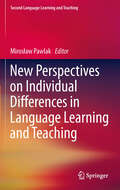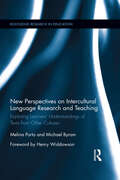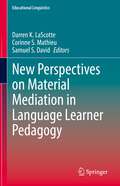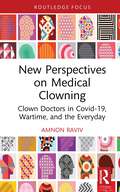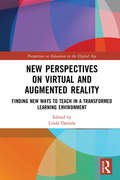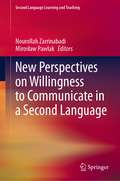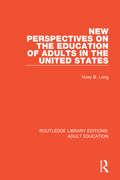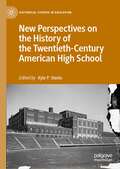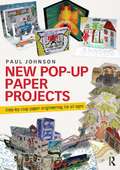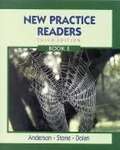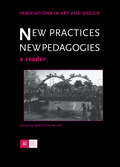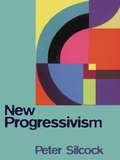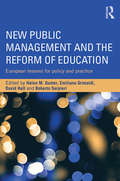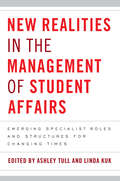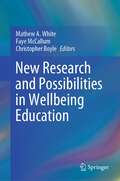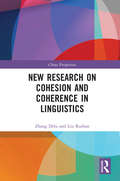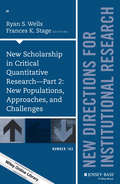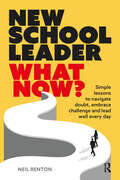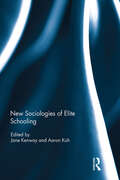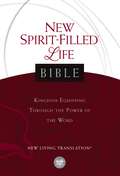- Table View
- List View
New Perspectives on Individual Differences in Language Learning and Teaching
by Mirosław PawlakThe volume constitutes an attempt to capture the intricate relationship between individual learner differences and other variables which are of interest to theorists, researchers and practitioners representing such diverse branches of applied linguistics as psycholinguistics, sociolinguistics, pragmatics or language teaching methodology. It brings together contributions by Polish and international authors, including leading experts in the field, touching upon changing perspectives on individual variation, cognitive, affective and social variables, learning deficits as well as their impact on learning and teaching. It offers a multifaceted perspective on these problems and shows how theory and research can be translated into classroom practice.
New Perspectives on Intercultural Language Research and Teaching: Exploring Learners’ Understandings of Texts from Other Cultures (Routledge Research in Education)
by Michael Byram Melina PortoIllustrated by an empirical study of English as a Foreign Language reading in Argentina, this book argues for a different approach to the theoretical rationales and methodological designs typically used to investigate cultural understanding in reading, in particular foreign language reading. It presents an alternative approach which is more authentic in its methods, more educational in its purposes, and more supportive of international understanding as an aim of language teaching in general and English language teaching in particular.
New Perspectives on Internationalization and Competitiveness
by Eskil UllbergThis volume showcases contributions from leading academics, educators and policymakers derived from two workshops hosted by the Interdisciplinary Center for Economic Science (ICES) at George Mason University on internationalization and competitiveness. It aims to present key areas of current research and to identify basic problems within the field to promote further discussion and research. This book is organized into two sections, focusing on: science and economics and innovation policy and its measurement, with an underlying emphasis on exploring connections across disciplines and across research, practice and policy. The first workshop was held at George Mason University (GMU) in Arlington, VA, USA in March 2013 and a second, building on the key results from the first, was held at the Royal Institute of Technology (KTH) in Stockholm, Sweden in October 2013. A variety of problems were discussed and several interdisciplinary concepts in internationalization and competitiveness have already emerged from these workshops. For example, many of the presentations emphasized a need for productivity, which is a key goal of economic development. It was proposed to shift the emphasis from productivity towards creativity by examining property right regimes and their measurement to provide incentives for creative idea generation. These regimes span across higher education, invention, labor markets, and many other markets and institutions. Addressing fundamental issues along four dimensions--economics, higher education, strategic collaboration, and new research methods--this book provides a multidimensional, interdisciplinary perspective on the challenges and opportunities for future development. This excellent collection of essays provides new insights as to how the development and diffusion of knowledge are facilitating convergence in the structure of research organizations across the globe -- a process that has enormous implications for how actors in all parts of the world compete with one another in an increasing array of arenas. The essays have valuable implications for understanding how producers of all kinds of knowledge across the globe are competing with one another and how geographical space and nation states are less important in the competition for novelty. Rogers Hollingsworth University of Wisconsin (Madison) University of California San Diego
New Perspectives on Material Mediation in Language Learner Pedagogy (Educational Linguistics #56)
by Darren K. LaScotte Corinne S. Mathieu Samuel S. DavidThis volume distinguishes itself from existing research on materials design, development, and evaluation, and focuses on material mediation in actual processes of teaching and learning, a subject that has been under-researched in the field of applied linguistics and second language education. This edited volume includes diverse perspectives on the roles that materials play in language learner pedagogy. Moving beyond the field of English language teaching, readers will find novel contributions offering a diversity of language teaching contexts, learner populations, and topics in the theory and/or practice of second and foreign language teaching. Chapters explore the ways in which affordances and constraints of classroom materials impact teachers and learners, while at the same time they bring their own (evolving) resources, identities, beliefs, and expertise to modify and adapt the materials to better suit their local language teaching and learning environments. As such, this text is ideal for use as supplemental reading in a wide variety of applied linguistics, second/foreign language education, TESOL, and instructional course design courses.
New Perspectives on Medical Clowning: Clown Doctors in Covid-19, Wartime, and the Everyday
by Amnon RavivTaking the recent coronavirus pandemic as a starting point, this book presents and analyzes new research around medical clowning in hospitals, from social media use to the impact on the hospitalized child in later life. This innovative book begins with an overview of the work of medical clowns. It discusses the idea of humor as a mechanism related to the revolution in language and human consciousness, and makes a connection between humor and anxiety, exploring how this can be mobilized to support hospitalized patients. There is extensive examination of medical clowning to strengthen coping skills and promote wellbeing in the time of Covid-19, where loneliness and isolation loomed large and anxieties were high. Subsequent chapters explore the role of medical clowning in wartime and at time of natural disasters, the experiences of children some time after their experience of hospitalization and clowning, and the role of social media and medical clowns in community building. This book is a fascinating contribution to the literature on medical clowning. It is of interest to researchers, practitioners, and lecturers in medical clowning, play in healthcare, nursing, medicine, and performance studies.
New Perspectives on Mind-Wandering
by Luca Tateo Nadia DarioIn the last decade, a great variety and volume of scholarly work has appeared on mind-wandering, a mental process involving a vast range of human life, connected with “first-person perspective” and “personhood”, submental thinking, mental autonomy, etc. While different and emerging features that flow into and out of one another (second field, mental travel, visual imagery, inner speech, unspecific memory, autobiographical memory, fantasies, introspection, etc.) and negative and positive approaches seem to describe mind-wandering, we offer an interdisciplinary theoretical and empirically informed and informative overview on mind-wandering studies and methodologies oriented toward the educational field. The aim is to transform and enrich the debate on mind-wandering but also to show how theoretical arguments and research findings could inform the teaching-learning context.This groundbreaking book, moves along three representations of developed scientific knowledge: imaginary lines, circles and spirals. The first section, “The Lines”, develops new lines of inquiry on attention (selective and sustained) and mind-wandering, the influence of age and mind-wandering, embodiment, consciousness and experience and mind-wandering. In the second section, the “Circles”, groups of Chapters on the same topic, methodology (tasks and measurement), intervention (auditory beat stimulation and mindfulness practices) and creativity, recreate a dance of interacting parts in which there are always profitable, decisive and retroactive exchanges between the information that each group or author activates. The last section, “The Spirals”, critically discusses the absence of a unified theoretical perspective, in the pedagogical field, attentive both to the processes of emergence and the interactions between parts.
New Perspectives on Virtual and Augmented Reality: Finding New Ways to Teach in a Transformed Learning Environment (Perspectives on Education in the Digital Age)
by Linda DanielaNew Perspectives on Virtual and Augmented Reality discusses the possibilities of using virtual and augmented reality in the role of innovative pedagogy, where there is an urgent need to find ways to teach and support learning in a transformed learning environment. Technology creates opportunities to learn differently and presents challenges for education. Virtual reality solutions can be exciting, create interest in learning, make learning more accessible and make learning faster. This book analyses the capabilities of virtual, augmented and mixed reality by providing ideas on how to make learning more effective, how existing VR/AR solutions can be used as learning tools and how a learning process can be structured. The virtual reality (VR) solutions can be used successfully for educational purposes as their use can contribute to the construction of knowledge and the development of metacognitive processes. They also contribute to inclusive education by providing access to knowledge that would not otherwise be available. This book will be of great interest to academics, researchers and post-graduate students in the field of educational technology.
New Perspectives on Willingness to Communicate in a Second Language (Second Language Learning and Teaching)
by Mirosław Pawlak Nourollah ZarrinabadiThis edited collection provides a state-of-the art overview of research on willingness to communicate (WTC) in a second and foreign language. In particular, it includes innovative studies seeking to demonstrate the ways in which WTC can be examined within the framework of complex dynamic systems, how the construct is related to self-assessment, reticence and extroversion, and what is signifies in the case of immigrants. Another group of papers is related to the role of technology in fostering WTC in different contexts. The volume also comprises papers that touch on methodological issues in the study of WTC such as experience case sampling, the network approach or the integration of the macro- and micro-perspective. The book will be of values to researchers interested in the study of WTC but will also provide inspiration for students, teachers and materials writers.
New Perspectives on the Education of Adults in the United States (Routledge Library Editions: Adult Education)
by Huey B. LongOriginally published in 1987 this book addresses practical issues in the education of adults in the USA but also encompasses theoretical and abstract ideas. There are chapters on 20th century initiatives in American adult education as well as education of the elderly and adult literacy.
New Perspectives on the History of the Twentieth-Century American High School (Historical Studies in Education)
by Kyle P. SteeleThe growth of the American high school that occurred in the twentieth century is among the most remarkable educational, social, and cultural phenomena of the twentieth century. The history of education, however, has often reduced the institution to its educational function alone, thus missing its significantly broader importance. As a corrective, this collection of essays serves four ends: as an introduction to the history of the high school; as a reevaluation of the power of narratives that privilege the perspective of school leaders and the curriculum; as a glimpse into the worlds created by students and their communities; and, most critically, as a means of sparking conversations about where we might look next for stories worth telling.
New Pop-Up Paper Projects: Step-by-step paper engineering for all ages
by Paul JohnsonNew Pop-Up Paper Projects is an inspirational book for everyone who wants to learn and share the magic of pop-up paper engineering. Illustrated throughout with colour diagrams and photographs, this book guides you through basic techniques and foundation skills, offers advice on classroom planning and health and safety and shows you how to ensure that learners of all ages can develop and progress their skills. Guiding you through 90-, 180- and 360-degree engineering, this book presents step-by-step instructions and ideas for over 200 cross-curricular themes, from cityscapes to magical creatures. Aiming to challenge and inspire, Paul Johnson uses over 150 paper-engineering techniques, including: storybooks pop-ups without folds zigzag pop-ups pulleys, wheels and levers asymmetrical pop-ups intricate toy theatres diagonal pop-ups with movables. This book, brimming with pop-up techniques and how to teach them, is for everyone – from the self-styled ‘visually illiterate’ to the art graduate, from parents keeping creativity alive at home to classroom teachers planning an engaging curriculum for their class of 30 plus pupils.
New Practice Readers (Third Edition): Book E
by Donald G. Anderson Clarence R. Stone Ellen Dolan"This book is one of a seven-book series. It is intended to provide reading interest along with the development of comprehension skills for readers who need additional practice material to achieve mastery. The controlled reading level of each book makes it possible to assign students to the text most suitable for individual reading comfort. Readabilities for this book are 5.0-5.8, consistent with the Dale-Chall Readability Formula. This book contains nine groups of articles in units labeled A-I. The subjects cover the major content fields listed below. 1. People and progress 2. Reptiles and sea life 3. Health and safety 4. Insects 5. Plants and products 6. Mammals and birds 7. Miscellaneous 8. Heroes and heroines 9. Instruments and measures."
New Practices - New Pedagogies: A Reader (Innovations in Art and Design)
by Malcolm MilesWith radical changes happening in arts over the past two decades, this book brings us up to date with the social and economic contexts in which the arts are produced. Influential and knowledgable leaders in the field debate how arts education - particularly in visual art - has changed to meet new needs or shape new futures for its production and reception. Opening up areas of thought previously unexplored in arts and education, this book introduces students of visual culture, peformance studies and art and design to broad contextual frameworks, new directions in practice, and finally gives detailed cases from, and insights into, a changing pedagogy.
New Practices of Comparison, Quantification and Expertise in Education: Conducting Empirically Based Research
by Christina Elde Mølstad Daniel PetterssonNew Practices of Comparison, Quantification and Expertise in Education discusses contemporary trends and activities related to comparisons and quantifications. It aims to help scholars to conduct empirically based research on how comparisons and quantifications are instituted in practice at different levels in the educational system. The book furthers discussions on policy by looking at the kinds of activities that comparisons and quantifications lead to at an international, regional and national level. Most of the book’s chapters are based on empirical research conducted in different research projects. The book thus brings all these projects together and discusses them as activities promoted by the reasoning of comparisons and quantifications. New Practices of Comparison, Quantification and Expertise in Education will be of great interest to academics, researchers and post-graduate students in the fields of comparative education, curriculum research and policy studies. It will also appeal to those in the fields of teacher education, including student teachers.
New Progressivism
by Peter SilcockMany useful things that progressivism has to offer (child-centred approaches, flexibility of response, negotiated and democratic classroom organisation) have been swept aside in the march of traditionalist policy. Taking robust theories of developmental psychology derived from the work of Swiss psychologist Piaget and Russian developmentalist Vygotsky, Silcock reasserts the need to explore the positive potential of new progressivism, and looks at how progressivist approaches can help teachers improve their classroom.
New Public Management and the Reform of Education: European lessons for policy and practice
by David Hall Helen M. Gunter Roberto Serpieri Emiliano GrimaldiNew Public Management and the Reform of Education addresses complex and dynamic changes to public services by focusing on new public management as a major shaper and influencer of educational reforms within, between and across European nation states and policy actors. The contributions to the book are diverse and illustrate the impact of NPM locally but also the interplay between local and European policy spheres. The book offers: A critical overview of NPM through an analysis of debates, projects and policy actors A detailed examination of NPM within 10 nation states in Europe A robust engagement with the national and European features of NPM as a policy strategy The book actively contributes to debates and analysis within critical policy studies about the impact and resilience of NPM, and how through a study of educational reforms in a range of political systems with different traditions and purposes a more nuanced and complex picture of NPM can be built. As such the book not only speaks to educational researchers and professionals within Europe but also to policymakers, and can inform wider education and policy communities internationally.
New Realities in the Management of Student Affairs: Emerging Specialist Roles and Structures for Changing Times
by Ashley Tull Linda KukStudent affairs organizations are at a crossroads. They face expanding enrollments; a concomitant increase need for often more complex services; changing demographics; a growing cohort of non-traditional and first-generation students; shifting and more demanding responsibilities; and increased expectations from the greater campus community, parents, and external constituents. These challenges are intensified by the accelerating speed of advancements in technology, globalization, innovation, and student consumerism; and by the long-term reality of shrinking resources, and limitations on the ability to increase tuition and fees. This book shares alternative ideas about organizational design, and about ways to restructure roles and responsibilities to enable student affairs organizations to respond to these challenges and demands more effectively at a time of reduced resources. It also addresses the many emerging roles that student affairs organizations are increasingly being expected to address – such as IT, fund raising and development, external communications, human resources management and professional development, as well as research and assessment – and describes approaches developed by a variety of institutions. The contributors also pay attention to the solutions appropriate for smaller institutions, and for community colleges. They explore the various dimensions of change and offer frameworks to help student affairs leaders and practitioners to more effectively understand and manage the changes they are confronting; and describe ideas and solutions adopted by others within the profession.
New Research and Possibilities in Wellbeing Education
by Christopher Boyle Mathew A. White Faye McCallumThis book examines a variety of issues related to wellbeing education and cross-cultural education, curriculum and pedagogy, education policy and systems, teacher education and professional development of educators, educational administration, management and leadership, and inclusive education. Stimulated, in part, by the launch of positive psychology, wellbeing education has grown worldwide. Various theories of wellbeing have been adopted in education, coining the term 'wellbeing education', defined in this book as how school leaders and teachers plan to implement evidence-informed wellbeing interventions to promote wellbeing and academic goals. This book investigates a series of questions related to wellbeing education, and how evidence-informed wellbeing approaches are integrated into learning, teaching, and education.
New Research on Cohesion and Coherence in Linguistics (China Perspectives)
by Zhang Delu Liu RushanThe study of text cohesion and coherence has been a topic of heated discussion in Linguistics since the 1990s. Western linguists have developed two major theoretical frameworks to describe the relationship between the two concepts: one posits that cohesive devices are important means to ensure cohesion; the other argues that coherence does not rely on cohesion. Yet neither has complete explanatory power over reality; nor can they solve real-life problems. This title proposes a creative, concrete, and highly operational theoretical model that unites cohesion and coherence using authentic English or Chinese examples. The authors clarify the concepts of coherence and expand the scope of the research by focusing on a variety of internal and external factors, such as psycho-cognitive and socio-cultural factors. Moreover, the authors propose that the new theoretical paradigm can be applied to a range of other disciplines, including translation and foreign language teaching. This title has been one of the most cited works on cohesion and coherence in China. Students and scholars of discourse analysis, linguistics, and language education will find this an invaluable reference.
New Scholarship in Critical Quantitative Research, Part 1: New Directions for Institutional Research, Number 158 (J-B IR Single Issue Institutional Research)
by Frances K. Stage Ryan S. WellsThis volume presents work focused on underrepresented persons in a variety of levels of higher education. Each scholar has used critical quantitative approaches to examine access and/or success in the higher education arena. Their scholarship pushes the boundaries of what we know by questioning mainstream notions of higher education through: the examination of policies the re-framing of theories and measures the reexamination of traditional questions for nontraditional populations. The work is divergent, but the commonality of the presentations lies in each scholar’s critical approach to conventional quantitative scholarship. Their research highlights inequities and explores factors not typically included in conventional quantitative analysis. This is the 158th volume of this Jossey-Bass quarterly report series. Always timely and comprehensive, New Directions for Institutional Research provides planners and administrators in all types of academic institutions with guidelines in such areas as resource coordination, information analysis, program evaluation, and institutional management.
New Scholarship in Critical Quantitative Research, Part 2: New Directions for Institutional Research, Number 163 (J-B IR Single Issue Institutional Research)
by Frances K. Stage Ryan S. WellsThis volume is the second in a two-part series on differentiating approaches to quantitative research from more traditional positivistic and postpositivistic approaches. While the first volume provided an expanded conceptualization of critical quantitative inquiry, this volume concludes the series by: applying critical quantitative approaches to new populations of college students who are rarely addressed in institutional and higher education research, such as American Indian, Alaska Native, and students with disabilities, applying the principles of quantitative criticalism to advanced methods of statistical analysis, and discussing the variety of challenges to overcome and presenting a future research agenda using these methods. This work is of interest to institutional and higher education researchers who want to expand and critique new ways of thinking about the broad array of populations participating in and served by higher education, while keeping in mind the goals of revealing inequity, challenging marginalization, and helping all students to succeed.This is the 163rd volume of this Jossey-Bass quarterly report series. Timely and comprehensive, New Directions for Institutional Research provides planners and administrators in all types of academic institutions with guidelines in such areas as resource coordination, information analysis, program evaluation, and institutional management.
New School Leader: Simple lessons to navigate doubt, embrace challenge and lead well every day
by Neil RentonWritten for all school leaders and headteachers who are feeling daunted by their new role or need a little inspiration and encouragement in an existing role. Neil Renton answers that simple question - what now? - with guidance to help navigate feelings of self-doubt and overcome leadership challenges.It is based on the author's own experience as he tells the uplifting and incredibly honest story of his leadership journey as the new headteacher of one of the largest comprehensive schools in the North of England. Neil Renton captivates you with his story, from being appointed in late 2018, leading through a pandemic, and coping with an Ofsted inspection. It examines the kinds of challenges that new leaders face and how they can be overcome, dealing with both one-off events and the every day of school leadership.The book provides a clear focus on those first moments, months and years of being a new school leader. Its four part structure covers navigating doubt, conquering challenges, the basics of leading every day, and creating the right mindset and culture. It encourages critical reflection based on both serious and humorous stories while offering practical advice and strategies for effective educational leadership.
New Science of Learning
by Myint Swe Khine Issa M. SalehThe earliest educational software simply transferred print material from the page to the monitor. Since then, the Internet and other digital media have brought students an ever-expanding, low-cost knowledge base and the opportunity to interact with minds around the globe--while running the risk of shortening their attention spans, isolating them from interpersonal contact, and subjecting them to information overload. The New Science of Learning: Cognition, Computers and Collaboration in Education deftly explores the multiple relationships found among these critical elements in students' increasingly complex and multi-paced educational experience. Starting with instructors' insights into the cognitive effects of digital media--a diverse range of viewpoints with little consensus--this cutting-edge resource acknowledges the double-edged potential inherent in computer-based education and its role in shaping students' thinking capabilities. Accordingly, the emphasis is on strategies that maximize the strengths and compensate for the negative aspects of digital learning, including: Group cognition as a foundation for learning Metacognitive control of learning and remembering Higher education course development using open education resources Designing a technology-oriented teacher professional development model Supporting student collaboration with digital video tools Teaching and learning through social annotation practices The New Science of Learning: Cognition, Computers and Collaboration in Education brings emerging challenges and innovative ideas into sharp focus for researchers in educational psychology, instructional design, education technologies, and the learning sciences.
New Sociologies of Elite Schooling
by Jane Kenway Aaron KohElite schools have an intriguing capacity to endure and adapt in the face of social, cultural and political change. They help both to reproduce power, privilege and status and also to regularly produce them afresh. The intricacies involved, over time and place, have attracted the abiding empirical, methodological and conceptual interest of sociologists and historians; recently, anthropologists and geographers have also responded to their allure. Collectively, the focus of such studies is usually on class making and the manner in which gender and race/ethnicity, place and mobility overlap and are part of the mix. This edited collection is framed around the notion of a ‘new sociology of elite education’, but it speaks into this wider space of inquiry in which studies of such schools are becoming more interdisciplinary. In so doing it brings together a new array of conceptual and theoretical tools while also deepening those that already exist. The contributions examine various configurations of contemporary class making and their attendant politics. These explorations are situated in the specificities of geographical locales where the complex dynamics of both national/local educational priorities and global/transnational forces are played out. In addition to showing how these dynamics put pressure on elite schools to redefine them, the book’s diverse international focus shines a light on new and emerging global patterns. This book was originally published as a special issue of British Journal of Sociology of Education.
New Spirit-Filled Life Bible, New Living Translation
by Jack HayfordFind the Holy Spirit throughout the Bible. Dr. Jack Hayford, founding pastor of The Church on the Way, has led a team of anointed leaders to produce the New Spirit-Filled Life Bible. This outstanding resource offers a fresh look at the Scriptures and the work of the Holy Spirit. This Bible addresses important issues of Spirit-filled living in the context of solid biblical scholarship.Features include:Kingdom Dynamics - 41 themes throughout the Scripture that give us values as we advance the gospel throughout the worldWord Wealth - More than 550 key terms defined and brought to life pulling the language from the original Greek and Hebrew to everyday EnglishTruth-In-Action - Practical charts pulling out practical application from every book of the BibleDetailed book introductionsVerse-by-verse study notesSpirit-Filled Life Bibles sold to date: More than 2 million
